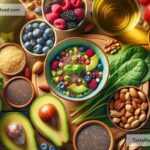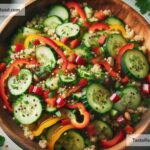Foods for Reducing Premenstrual Syndrome (PMS)
Premenstrual Syndrome, or PMS, is something many women deal with every month. The symptoms of PMS can vary from person to person, but they often include mood swings, bloating, fatigue, headaches, irritability, and food cravings. While PMS is a natural part of the menstrual cycle, it doesn’t have to be so uncomfortable. One of the best ways to manage PMS symptoms is through the food you eat. Certain foods can help balance hormones, reduce inflammation, and support your overall health during this time. In this article, we’ll talk about simple, everyday foods that can ease PMS and make “that time of the month” a little smoother.
Why Food Matters for PMS
Hormones play a big role in your menstrual cycle, and they’re also responsible for PMS symptoms. Your body needs the right nutrients during this time to keep your hormones balanced. Certain foods can help reduce cramps, stabilize mood, and lower bloating. On the other hand, eating junk food or highly processed snacks can make PMS symptoms worse. This is why healthy eating matters!
Key Nutrients That Help with PMS
Before diving into specific foods, it’s helpful to know which nutrients can target PMS. Here are some key players:
- Magnesium: Helps reduce muscle cramps, headaches, and irritability.
- Calcium: Supports mood stability and may ease bloating.
- Vitamin B6: Great for fighting fatigue and mood swings.
- Omega-3 Fatty Acids: Reduces inflammation and pain caused by cramps.
- Iron: Replenishes your energy levels, especially after your period starts.
- Fiber: Helps regulate digestion and reduce bloating.
- Potassium: Prevents water retention and bloating.
Foods That Help with PMS
1. Leafy Greens
Spinach, kale, Swiss chard, and other leafy greens are rich in magnesium, calcium, and iron. Magnesium can help calm painful cramps, while calcium balances hormones and supports your mood. Iron is especially important if heavy bleeding during your period leaves you feeling tired. Leafy greens are easy to add to foods like salads, soups, or smoothies.
2. Bananas
Bananas are packed with potassium, magnesium, and vitamin B6. They’re the perfect food for managing bloating, cramps, and irritability. If you’re experiencing sugar cravings during PMS, bananas are a healthier choice than candy. Eat them as a snack or add them to oatmeal or yogurt.
3. Salmon
Salmon is high in omega-3 fatty acids, which are known to reduce pain and inflammation. Omega-3s relax your muscles and relieve cramps. Salmon is also a good source of vitamin D, which can help regulate mood and lower PMS-related depression. Try baking, grilling, or incorporating salmon into tasty dishes.
4. Nuts and Seeds
Almonds, walnuts, sunflower seeds, chia seeds, and flaxseeds are great snacks for PMS relief. These foods are rich in magnesium, healthy fats, and fiber. Magnesium fights fatigue and muscle tension, while fiber improves digestion, reducing bloating. Sprinkle seeds on your breakfast or grab a handful of nuts for an easy snack.
5. Dark Chocolate
Good news for chocolate lovers! Dark chocolate (preferably 70% cacao or more) is high in magnesium. Eating a small square of dark chocolate can reduce stress, improve mood, and curb sugar cravings during PMS. Just make sure to enjoy it in moderation to avoid overloading on sugar.
6. Whole Grains
Foods like quinoa, brown rice, oats, and whole-grain bread provide fiber, B vitamins, and complex carbohydrates. Fiber helps with digestion and reduces bloating, while B vitamins support energy levels. Complex carbs stabilize blood sugar, preventing mood swings and fatigue.
7. Yogurt
Yogurt, especially plain Greek yogurt, is rich in calcium and probiotics. Calcium helps reduce muscle pain and mood swings, while probiotics improve gut health and reduce bloating. Top it with fruits or nuts for added flavor and nutrition.
8. Avocado
Avocados are full of healthy fats, potassium, and magnesium. They help fight bloating, cramps, and fatigue. Whether you add avocado to a salad, spread it on toast, or make guacamole, it’s a creamy and satisfying food that nourishes your body.
9. Herbal Teas
While not technically a food, herbal teas like chamomile, ginger, and peppermint can work wonders for PMS relief. Chamomile tea calms cramps and improves sleep, ginger tea reduces nausea and inflammation, and peppermint tea soothes bloating. Sip on warm tea for comfort and relaxation.
10. Fruits and Vegetables
Brightly colored fruits like oranges, berries, and kiwi are packed with vitamins, antioxidants, and water content. They help reduce bloating, hydrate your body, and stabilize energy levels. Vegetables like carrots, sweet potatoes, and bell peppers provide important nutrients to balance hormones.
Foods to Avoid During PMS
While adding nutrient-rich foods to your diet can help, it’s also important to avoid foods that make PMS symptoms worse. Limit or avoid:
- Sugary snacks: May lead to energy crashes and worsen mood swings.
- Salty foods: Can increase bloating and water retention.
- Caffeine: May make anxiety and irritability worse.
- Alcohol: Can dehydrate your body and disrupt hormone balance.
- Processed foods: Often lack nutrients and contain additives that irritate your body.
Final Thoughts
While PMS is a common experience, eating the right foods can make a big difference in how you feel during your cycle. Be kind to your body and choose nutrient-packed foods like leafy greens, bananas, salmon, and yogurt to reduce PMS symptoms. Remember, healthy habits and balanced meals can support your overall well-being—not just during your period but every day of the month!
Do you have any favorite foods that help you feel better during PMS? Let us know in the comments below!


